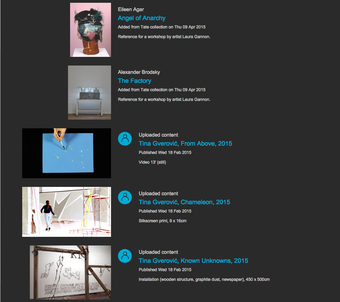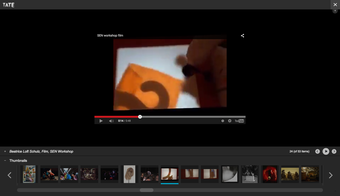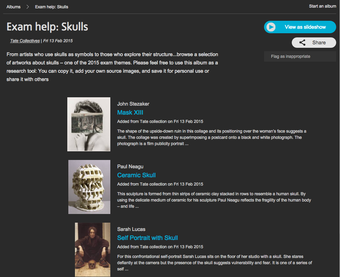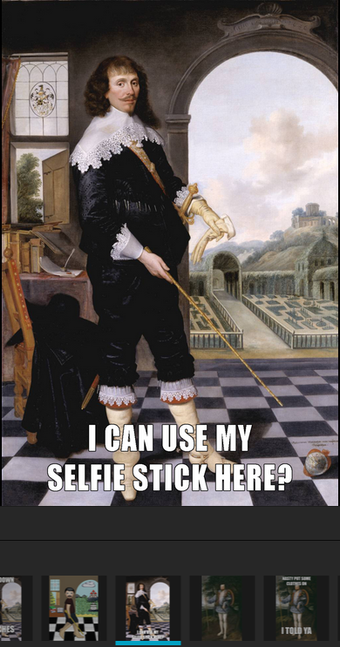In October 2014 we soft launched a major new feature onto the Tate website as part of the Archives and Access project. ‘Albums is a new tool which will let you group together art from our collection, add your own notes, and share it with others’ – as described by Emily Fildes the Digital Producer for the project at the time. We have only just begun to realise the possibilities for this new feature within the context of the project and further afield within art education, practice sharing and dialogue on the potential for digital interaction for users to the collection.
For this post we take a look at three ways in which Albums are being utilised by Learning Practitioners and Digital Producers to create spaces of new interaction between the collection and artist practice.
Albums for artist-led workshops

Close up of Schools and Teachers first Album – ‘Schools Workshop Artists 2014–15’View the full album
Sarah Jarvis (Assistant Curator, Schools and Teachers Team) details the use of Albums to share artist’s ideas, activities and approaches to running workshops at Tate Britain and Tate Modern
When articulating what a schools workshop consists of, we often refer to its three vital constituents: the artist, the Tate collection and the young people. Every year we recruit a new team of artists who are invited to consider these components and devise workshops framed by their own practice, current interests and ideas; a proposal valued as a way of maintaining young peoples’ closeness to Tate’s art collection, whilst forging connections with contemporary art practice.
This live approach is excitingly unpredictable and, in its nature, hard to pin down, so how can we be generous in articulating what might happen for teachers who would like to know more? How can we usefully share with our audience an essence of what they might encounter in a workshop, whilst respecting and protecting the open framework that we champion.
Our first Tate Album is an exercise in exploring this. By displaying a curated collection of ‘stimuli’ from the Tate collection, examples of the workshop artist’s own work and selected documentation from their past Tate workshop sessions, our hope is that the album visually brings together the three components; artist, collection, young people. It mirrors the liveness of the programme, opening possibilities, offering up comparisons, friendships and connections that go some way to illustrate what might happen, be looked at or considered in a workshop moment, when artist and young people come together in the unique context of the Tate collection and gallery space.

Close up of Schools and Teachers first Album – ‘Schools Workshop Artists 2014–15’View the full album
Themes and digital creativity
Jen Aarvold (Tate Collectives Digital Producer) goes onto explain the use of Albums to help art students tackle GCSE, AS and A2 exam topics
A few years ago we noticed a spike in certain thematic search terms on the Tate website, such as identity, journey or ritual. We discovered this coincided with the art exam themes being released, and students were coming to the Tate site in search of inspiration. With a collection spanning 61,060 images of artworks as part of Art and Artist along with 8,118 archive items (soon to be 52,000 archive pieces in total) we thought we could offer some help narrowing down relevant artists and artworks as well as unearthing some unusual suspects.

Close up of Tate Collectives Album ‘Skulls’ for help with research for GCSE and AS / A2 LevelView the full album
Whereas previously these exam help resources have existed as static pages on the website, this year we used Albums to group together a selection of Tate artworks, and embedded video content from Tate’s YouTube channel. As well as being a good way of pulling together by theme selections of Tate artworks, our hope was that students would make use of the ‘copy’ functionality and then add their own artwork or relevant research so the exam resource albums become a more interactive research space they can save and use as they prepare for their art exam. We also noticed, when researching online study resources for GCSE art and design subjects, that student discussion forums were buzzing with students seeking inspiration and sharing, or bouncing their ideas off others. The sharing option that the Albums feature offers makes them an ideal resource for students who want to share their thoughts and research with others working on similar themes.
Jen further discusses how Albums can be used to celebrate and showcase young peoples’ digital creativity in response to Tate artworks.
Tate Collectives regularly invite young people to take part in digital participatory projects. These projects usually centres around Tate’s collection and invite young people to remix, reinterpret or respond to artworks through digital media.

Close up of Tate Collectives Album ‘Open Call: Mememojis’ displaying a curated display of international submissions:View the full album
Usually the outcomes from these projects are shown in the physical gallery environment. But given the nature of digital, we often receive submissions from international young people who aren’t able to attend an event and see their work displayed. We used Albums to show a curated selection of young people’s submissions, adding the original Tate artworks to our Album and then uploaded young people’s responses. Not only does this celebrate and acknowledge our participants, it also gives legacy to the project. We hope the Albums can become a starting point for research, new ways of looking, thinking about or reinterpreting art.

Close up of Tate Collectives Album ‘Open Call: Mememojis’ displaying a curated display of international submissionsView the full album
So what does this do for art and archive interaction and access today?
Definitely the ability to group visual information such as this and to think through the artwork and the archive collection in tandem creates a unique space for dialogue; enabling teachers, artists and students to interact and make visible their ideas and invite comment.
Enabling a space where audience interaction can bleed more visibly into the institution or organisations programme of activity is also crucial as this brings an instantaneous commentary and diversity to the archive and art work collection.
In conclusion what will the future of Albums hold? Working with archive collections in this manner in which albums and bodies of work can be generated and curated by individuals, academic spaces and art organisations allows for a more fluid possibilities of exchange of ideas and thoughts – allowing for new platforms of archive activity in spaces it might not have originally been associated with.
